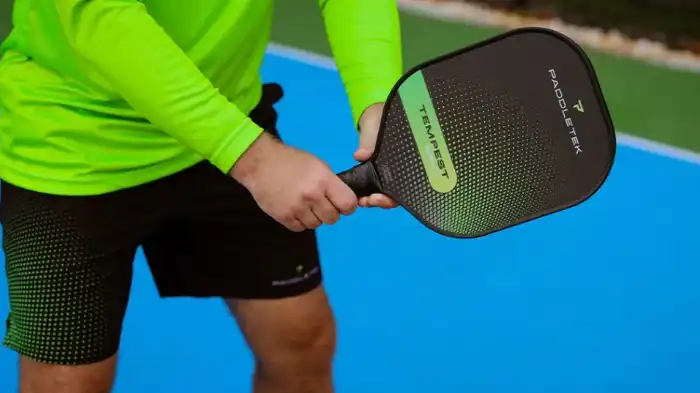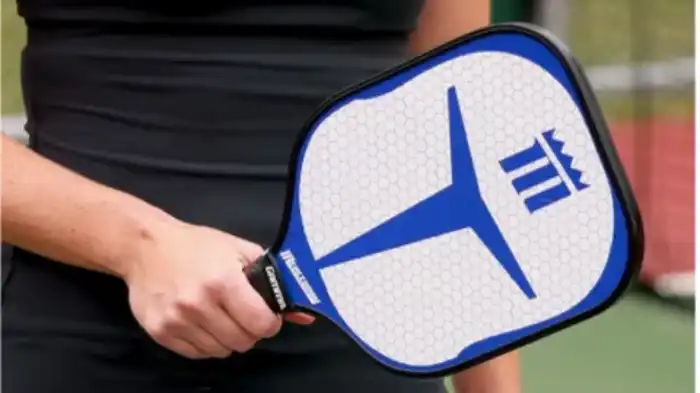Pickleball is a popular sport that combines elements of tennis, badminton, and table tennis. It is played with a paddle and a plastic ball on a court that is similar to a smaller version of a tennis court.
One of the key factors that can greatly influence your performance in pickleball is the grip of your paddle. Having the right grip ensures control, comfort, and accuracy during gameplay. In this blog post, we will explore the Best Grip for Pickleball and provide some useful tips to help you improve your game.

Types of Grips
There are several different types of grips that players can use in pickleball. Each grip has its own advantages and disadvantages, and it’s important to find the Best Grip for Pickleball, one that suits your playing style and personal preference. Let’s take a closer look at the most commonly used grips:
1. Eastern Forehand Grip
This grip is similar to the grip used in tennis. It involves gripping the paddle handle with your palm facing down, and your index knuckle resting against the back of the paddle. This grip provides excellent power and control, making it ideal for players who prefer to hit hard shots.
2. Western Forehand Grip
The Western Forehand Grip is similar to the Eastern Forehand Grip but with a slight modification. Instead of the index knuckle resting on the back of the paddle, the heel of the hand is placed near the bottom of the handle. This grip allows for greater topspin and is suitable for players who like to add spin to their shots.
3. Continental Grip
The Continental Grip is commonly used in tennis and provides a versatile grip for pickleball as well. In this grip, you hold the paddle handle similar to how you would hold a hammer. It allows for quick transition between different shots and is favored by many professional players.
4. Semi-Western Grip
The Semi-Western Grip is a hybrid between the Eastern Forehand Grip and the Western Forehand Grip. It provides a balance between power and spin, making it a popular choice among intermediate players. The index knuckle rests on the back of the paddle, while the heel of the hand is positioned slightly further down the handle compared to the Eastern grip.
Tips for Finding the Best Grip for Pickleball
Now that we have discussed the different types of grips, let’s explore some tips for finding the best grip for your pickleball game:
1. Experiment with Different Grips
It’s important to experiment with different grips to find the one that feels most comfortable and natural for you. What works for one player may not work for another, so take the time to try out different grips and see how they affect your gameplay.
2. Consider Your Playing Style
Your playing style can also influence the best grip for you. If you are a power player who likes to hit hard shots, the Eastern Forehand Grip may be a good choice. On the other hand, if you prefer adding spin to your shots, the Western Forehand Grip may suit you better.

3. Pay Attention to Comfort
Comfort is crucial when it comes to choosing a grip. Make sure the grip feels secure in your hand and doesn’t cause any discomfort or strain during gameplay. You may even consider using grip tapes or overgrips to enhance the comfort and grip of your paddle.
4. Seek Professional Advice
If you are still unsure about which grip to choose, it’s a good idea to seek guidance from a professional pickleball coach or experienced players. They can provide valuable insights and help you find the grip that suits you best.
Conclusion
The right grip can make a significant difference in your pickleball game. Whether you choose the Eastern Forehand Grip for power, the Western Forehand Grip for spin, or any other grip based on your playing style and comfort, practicing with it consistently is key to improving your skills. So, grab your paddle, try out different grips, and find the Best Grip for Pickleball, one that helps you unleash your potential on the pickleball court!
Frequently Asked Questions
The most commonly recommended grip for pickleball is the Continental grip. It provides a versatile grip that allows for a wide range of shots, including volleys, dinks, and smashes. It offers good control and stability, making it suitable for players of all skill levels.
Yes, players often switch to variations of the Eastern or Semi-Western grips for specific shots. The Eastern grip is beneficial for generating topspin on groundstrokes, while the Semi-Western grip is useful for executing powerful forehand shots. However, it’s important to practice and be comfortable with these grips before using them in game situations.
It is important to have a firm grip on the paddle to maintain control. However, gripping it too tightly can limit wrist movement and affect your shot accuracy. Find the right balance by holding the paddle with a firm enough grip to feel in control, while still allowing for flexibility and maneuverability.
Changing grips mid-game can be challenging and may result in errors if not executed correctly. It is generally recommended to stick with one grip that you are comfortable with throughout the game. However, if you are experienced and confident in employing different grips for specific shots, you can consider adapting based on the situation.
Yes, grip size and paddle dimensions play a vital role in selecting the best grip. The paddle should fit comfortably within your hand with enough space for a secure grip. If the grip is too big or small, it can cause discomfort or affect your control. It’s essential to choose a grip size and paddle dimensions that fit your hand and playing style to ensure optimal performance.

